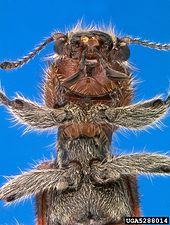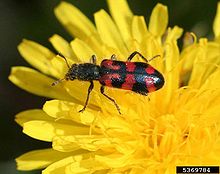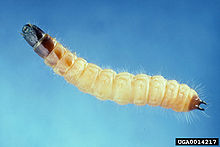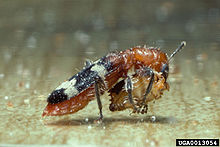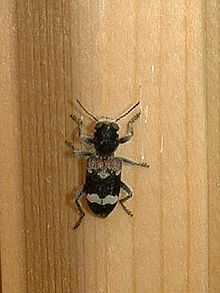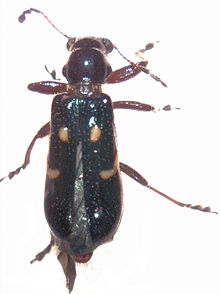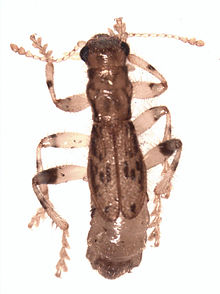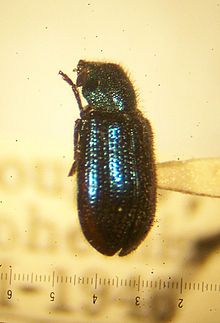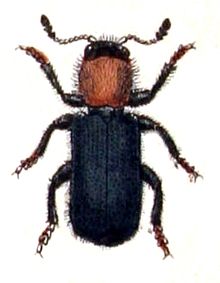- Cleridae
-
Cleridae 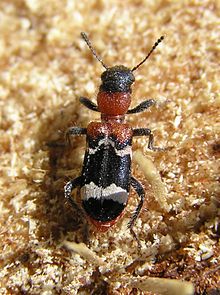
Thanasimus dubius (Clerinae) Scientific classification Kingdom: Animalia Phylum: Arthropoda Class: Insecta Order: Coleoptera Suborder: Polyphaga Infraorder: Cucujiformia Superfamily: Cleroidea Family: Cleridae
Latreille, 1802Subfamilies Clerinae Latreille, 1802
Enopliinae Gistel, 1856 (disputed)
Epiphloeinae Gistel, 1856 (disputed)
Hydnocerinae Spinola, 1844
Korynetinae Laporte, 1836
Tarsosteninae Jacquelin du Val, 1861 (disputed)
Thaneroclerinae Chapin, 1921[verification needed] (but see text)
Tillinae Leach, 1815
and see belowCleridae are a family of beetles of the superfamily Cleroidea. They are commonly known as checkered beetles. The Cleridae family has a worldwide distribution, and a variety of habitats and feeding preferences.
Cleridae have a large number of niches and feeding habits. Most genera are predaceous and feed on other beetles and larvae; however other genera are scavengers or pollen feeders. Clerids have elongated bodies with bristly hairs, are usually bright colored, and have variable antennae. Checkered beetles range in length between 3 millimeters and 24 millimeters. Cleridae can be identified based on their 5–5–5 tarsal formula, division of sternites, and the absence of a special type of vesicle. Female Cleridae lay between 28–42 eggs at a time predominately under the bark of trees. Larvae are predaceous and feed vigorously before pupation and subsequently emergence as adults.
Clerids have a minor significance in forensic entomology. Some species are occasionally found on carrion in the later dry stages of decay. Also, some species are pests (stored product entomology) and are found infesting various food products. Research efforts related to Cleridae have focused primarily on using certain species as biological controls. This is a very effective technique for controlling bark beetles due to the voracious appetite of many Clerid species.
Contents
Physical description
Appearance
Generally, checkered beetles are elongated and oval in shape and range from 3–24 millimeters (.1–1 in).[1] Their entire bodies are covered with bristly hairs, and many display an ornate body color pattern.[1] These often brightly color patterns can be red, yellow, orange, or blue.[2] The antennae are clubbed at the tip for most species, but others can be “clubbed, saw-tooth, or thread-like.”[1][2] The pronotum region is nearly cylindrical and characteristically narrower than the elytra (special hardened front wings), while the head is as wide or wider than the pronotum.[2] Their elytra have tiny pits or depressions, and never expose more than two tergites (dorsal plates).[1]
Identification
Clerid beetles fall under the suborder Polyphaga. Key characteristics of Polyphaga are that the hind coxa (base of the leg), do not divide the first and second abdominal/ventral plates which are known as sternites. Also, the notopleural suture (found under the pronotal shield) is not present.[1] To further identify Clerid beetles, a few additional characteristics need to be examined.
Clerid beetles have unique legs that help to distinguish them from other families. Their tarsal formula is 5–5–5, meaning that on each of the front, middle and hind legs there are 5 tarsomeres (individual subsegments of the feet/tarsi).[1] One or more of these subsegments on each leg is typically lobed, and the 4th tarsi is normally difficult to distinguigh. Furthermore, an important feature that eliminates many other families of beetles is that Clerids' front coxae (base of the leg) expose the second segment of the legs known as the trochanter.[1]
The second defining characteristic of the Cleridae family is that Clerids never have eversible vesicles (small usually hidden balloon-like structures thought to be scent glands) on their abdomen and pronotum. This characteristic distinguishes them from a similar family Melyridae which sometimes has these glands.[1] This trait is very important in correctly differentiating checkered beetles from Melyridae.
Distribution and ecology
Cleridae can be found in the Americas, Africa, Europe, the Middle East and even in Australia. There are approximately 3,500 species in the world and about 500 species in North America.[3] Due to this wide distribution there are many different habitats in which the checkered beetles can be found.
Many of the species are known as "flower visitors", that prey on other flower visiting insects and also feed on pollen. These species are found in moist, sunny environments where flowering plants are found in abundance.[4]
Another habitat commonly inhabited by beetles in the Cleridae family is trees. These "tree living species" are found in forests across the world with various climates and an array of easily preyed upon insects. They seek protection under the bark and hunt for other insects above and below the bark.[4] The primary source of prey for these bark living hunters is bark beetles.
The third type of clerid beetles is the "nest robbing species" which live in shrubbery and in trees. Unlike the tree living species these species do not actually burrow into the bark. Nest robbing species typically hunt termite, bee, and wasp larvae, and one particular species has been noted to prey primarily on grasshopper egg masses.[4] Not all nest robbing species actively hunt live prey, some species for example prefer to feed only on dead honey bee larvae and adults.[4]
Feeding habits
The Cleridae family contains many species of predaceous beetles that feed on other beetles and beetle larvae in their natural habitat.[3] The most common prey item for checkered beetles are the bark beetles and wood boring beetles.[5]
In general, the bulk of adult Cleridae feed mainly on other adult beetles while the larvae stage feed on other beetle larvae. Some checkered beetles are known to have an extremely voracious appetite with some larvae able to consume "several times their own body weight” in a day.[6]
Although most species of checkered beetles are predaceous in nature, some are scavengers and others have been found feeding on flower pollen.[7] Because of the checkered beetles predaceous nature and insatiable appetite, they are often key players in the biological control of other insects. The checkered beetles have also developed a unique adaptation to aid in their quest for prey. The beetles use pheromones to help them locate, kill, and consume their prey.[8]
The diversity of checkered beetle's feeding habits is quite evident when different species are examined. The Necrobia spp. are attracted to dry carrion and other decomposing animal matter such as bones and skin as well as various meat products.[9] Thanasimus spp. are found in woodland areas where bark beetle species constitute their main source of prey.[9] The primary source of prey for the Phyllobaenus spp. are wood borers, immature weevils, and hymenoptera larvae.[9] One of the more diverse genera is Trichodes, the larvae feed on the pollen of flowering plants and adults prey upon grasshoppers and wasps.[9]
Life cycle
The general life cycle of clerids has been known to last anywhere from 35 days to more than 3 years, and is strongly dependent on the life cycle of their prey.[10] While the life cycle can vary in length between genus and species, temperature is also a major determinant in the length of time spent in each stage of development. The warmer the temperature is, the quicker the lifecycle, and the cooler the temperature is the slower the lifecycle. If temperatures dip below a threshold temperature for an extended period of time Clerids and most other insects will have growth and developmental progress arrested. Cleridae exhibit a holometablolous development. A majority of the known Cleridae species larvae feed upon the eggs and young of wood-boring beetles, while the adults feed on the adult bark beetles.[11]
Copulation takes place while the female feeds, because females need a large amount of food for egg development.[12] The female lays her eggs 36–72 hours after copulation. The eggs are laid in between pieces of bark on wood-borer-infested trees or under stones in the soil.[11] She may lay 28–42 eggs at a time.[12] For the longer lifespaned species such as the Thanasimus sp. this occurs in late summer or early fall to give the larvae enough time for proper growth before having to overwinter.[13]
When larvae hatch from their eggs, they are either red or yellow.[11] Their bodies have a slender and flat appearance with short legs due to their minimal movement. The larvae are covered in hair and have two horn-type projections on the dorsal area of the last body segment.[11] Immediately after birth, they start searching for food close to where they hatched. They feed on wood-borer insects on trees, or feed on their species' substrate or prey of choice.[11] Feeding is the main purpose of the larval stage to prepare for pupation. Once their larval stage is complete the tree dwelling species make their way to the bottom of the tree to pupate.[13] The pupal stage can last from 6 weeks to one year depending on the need to overwinter, and how short the overall lifecycle is for a particular species. A majority of Cleridae species pupate in earthen cells which are made from soil and certain enzymes secreted from their mouths.[11] The rest remain in pupal cells. Adult beetles emerge from pupation and spend a variable time of their life maturing, and eventually oviposit. Sexually mature adults or imagos of Thanasiumus sp. overwinter inside the wood-borer-infested trees and oviposit during the spring.[12]
Forensic relevance
Stored product entomology
Necrobia rufipes, commonly known as the red-legged ham beetle, is of particular importance in stored product entomology. N. rufipes infests dried or smoked meats, especially those products that are stored unwrapped for long periods of time. Adults feed on the surface of the products, while the larvae damage the meat by boring down usually in the fatty parts.[14] N. rufipes has been recorded to have fed upon a large variety of items ranging from hides and dried figs to Egyptian mummies.[14] In addition, products such as wool and silk can become infested, but not destroyed.[14]
Medico-legal entomology
Since Clerids are predaceous in nature, they have been found feeding on fly larvae as well as the skin and bones of carrion.[9] Most members of the Cleridae family are not useful in forensics because of their food choice, but some species such as the Necrobia rufipes can be useful. Necrobia rufipes is attracted towards carrion in the later stages of decomposition, so its arrival on carrion can help provide an estimate for the post-mortem interval or PMI. Although the checkered beetle is not the most significant insect on carrion, the beetles predaceous nature and its ability to reproduce in carrion that is exposed to the environment provides some forensic importance.[15]
Ongoing research
There is ongoing research with some of the members of the Cleridae family. Forensic research is limited because of their late arrival on carrion, but members such as Thanasimus undatulus have been researched as a possible role in integrated pest management or IPM. Thanasimus undatulus is a predator of bark beetles. Some species of bark beetles such as the southern pine beetle and the mountain pine beetle can become pests to the lumber industry because in large numbers they can cause damage and kill live trees. Thanasimus undatulus has been researched as a possible biological control agent for these pests. Researchers and forestry officials have used bark beetle aggreagation pheromones to attract the checkered beetle to specific trees. This causes the bark beetles to be overwhelmed, extensively preyed upon by the Clerid beetles, and typically eliminated.[16] There is also additional research being done pertaining to the impact of Cleridae beetles on pollination in flowers.[17]
Systematics
The genera of Cleridae are divided among several subfamilies, though some genera still defy easy classification. Several taxonomic schemes exist, recognizing for example a group around Neorthopleura as distinct subfamily Neorthopleurinae, or splitting off the Thaneroclerinae as distinct family, or circumscribing the Korynetinae sensu stricto or sensu lato. The following list of tribes and selected genera is thus preliminary. Some notable species are also listed.
Clerinae
- Allonyx Jacquelin du Val, 1860
- Anthicoclerus Schenkling, 1906
- Aphelochroa Quedenfeldt, 1885
- Apopempsis Schenkling, 1903
- Apteroclerus Wollaston, 1867
- Aptinoclerus Kuwert, 1893
- Aradamicula Sedlacek & Winkler, 1975
- †Arawakis (fossil)
- Astigmus Kuwert, 1894
- Aulicus Spinola, 1841
- Axina Kirby, 1818
- Balcus
- Barriella Opitz, 2003
- Barrotillus Rifkind, 1996
- Blaxima Gorham, 1882
- Bousquetoclerus Menier, 1997
- Burgeoneus Pic, 1950
- Caestron Dupont in Spinola, 1844
- Calendyma Lacordaire, 1857
- Canariclerus Winkler, 1982
- Cardiostichus Quedenfeldt, 1885
- Caridopus Schenkling in Sjöstedt, 1908
- Cleromorpha Gorham, 1876
- Cleropiestus Fairmaire, 1889
- Clerus Fabricius, 1775
- Clytomadius Corporaal, 1949
- Colyphus Spinola, 1841
- Coptoclerus Chapin, 1924
- Cormodes Pascoe, 1860
- Corynommadius Schenkling, 1899
- Ctenaxina Schenkling, 1906
- Ctenoclerus Solervicens, 1997
- Dasyceroclerus Kuwert, 1894
- Dasyteneclines Pic, 1941
- Dieropsis Gahan, 1908
- Dologenitus Opitz, 2009
- Dozocolletus Chevrolat, 1842
- Eburiphora Spinola, 1841
- Eburneoclerus Pic, 1950
- Ekisius Winkler, 1987
- Eleale Newman, 1840
- Enoclerus Gahan, 1910
- Epiclines Chevrolat in Guérin-Ménéville, 1839
- Eunatalis Schenkling, 1909
- Eunatalis porcata
- Erymanthus Spinola, 1841
- Eurymetomorphon Pic, 1950
- Falsomadius Gerstmeier, 2002
- Falsoorthrius Pic, 1940
- Graptoclerus Gorham, 1901
- Gyponyx Gorham, 1883
- Hemitrachys Gorham, 1876
- Homalopilo Schenkling, 1915
- Inhumeroclerus Pic, 1955
- Jenjouristia Fursov, 1936
- Languropilus Pic, 1940
- Lissaulicus C.O.Waterhouse, 1879
- Memorthrius Pic, 1940
- Metademius Schenkling, 1899
- Microclerus Wollaston, 1867
- Micropteroclerus Chapin, 1920
- Microstigmatium Kraatz, 1899
- Mimolesterus Gerstmeier, 1991
- Mitrandiria Kolibac, 1997
- Myrmecomaea Fairmaire, 1886
- Natalis Laporte de Castelnau, 1836
- Neogyponyx Schenkling, 1906
- Neoscrobiger Blackburn, 1900
- Ohanlonella Rifkind, 2008
- Olesterus Spinola, 1841
- Omadius Laporte de Castelnau, 1836
- Oodontophlogistus Elston, 1923
- Operculiphorus Kuwert, 1894
- Opilo Latreille, 1802
- Orthrius Gorham, 1876
- Oxystigmatium Kraatz, 1899
- Phlogistomorpha Hintz, 1908
- Phlogistus Gorham, 1876
- Phloiocopus Spinola, 1841
- Phonius Chevrolat, 1843
- Pieleus Pic, 1940
- Placocerus Klug, 1837
- Placopterus Wolcott, 1910
- Plathanocera Schenkling, 1902
- Platyclerus Spinola, 1841
- Priocera Kirby, 1818
- Priocleromorphus Pic, 1950
- Prioclerus Hintz, 1902
- Pseudolesterus Miyatake, 1968
- Pseudomadius Chapin, 1924
- Pujoliclerus Pic, 1947
- Sallea Chevrolat, 1874
- Scrobiger Spinola, 1841
- Sedlacekius Winkler, 1972
- Sikorius Kuwert, 1893
- Stigmatium Gray in Griffith, 1832
- Systenoderes Spinola, 1841
- Tanocleria Hong, 2002
- Thalerocnemis Lohde, 1900
- Thanasimodes Murray, 1867
- Thanasimus Latreille, 1806
- Thanasimus formicarius – Ant Beetle
- Tillicera Spinola, 1841
- Trichodes Herbst, 1792
- Trichodes alvearius
- Trichodes apiarius
- Trichodes leucopsideus
- Trogodendron Spinola, 1841
- Trogodendron fasciculatum – Yellow-horned Clerid
- Wilsonoclerus
- Winklerius Menier, 1986
- Wittmeridecus Winkler, 1981
- Xenorthrius Gorham, 1892
- Zahradnikius Winkler, 1992
- Zenithicola Spinola, 1841
Enopliinae (sometimes in Korynetinae)
- Antygodera
- Apolopha Spinola, 1841
- Corinthiscus Fairmaire & Germain, 1861
- Cregya LeConte, 1861
- Curacavi
- Enoplium Latreille, 1802
- Exochonotus
- Hublella
- Lasiodera Gray in Griffith, 1832
- Neopylus Solervicens, 1989
- Paracregya
- Pelonium
- Phymatophaea Pascoe, 1876
- Platynoptera Chevrolat, 1834
- Pseudichnea Schenkling, 1900
- Pylus Newman, 1840
- Pyticara Spinola, 1841 (including Pelonides)
- Thriocerodes Wolcott & Dybas, 1947
Epiphloeinae (sometimes in Korynetinae)
- Acanthocollum
- Amboakis
- Decaphloeus
- Decorosa
- Diapromeces Opitz, 1997
- Ellipotoma Spinola, 1844
- Epiphloeus Spinola, 1841
- Hapsidopteris Opitz, 1997
- Ichnea Laporte de Castelnau, 1836
- Iontoclerus Opitz, 1997
- Katamyurus Opitz, 1997
- Madoniella Pic, 1935
- Megaphloeus
- Megatrachys Opitz, 1997
- Neichnea
- Opitzius Barr, 2006
- Parvochaetus Opitz, 2006
- Pennasolis
- Pericales
- Phlogistosternus
- Pilosirus Opitz, 1997
- Plocamocera Spinola, 1844
- Pteroferus
- Pyticeroides Kuwert, 1894
- Silveirasia
- Stegnoclava
- Turbophloeus
Hydnocerinae (including Phyllobaeninae)
- Abrosius Fairmaire, 1902
- Achlamys C.O.Waterhouse, 1879
- Allelidea G.R.Waterhouse, 1839
- Blaesiophthalmus Schenkling, 1903
- Brachycallimerus Chapin, 1924
- Brachyptevenus
- Callimerus Gorham, 1876
- Cephaloclerus Kuwert, 1893
- Cucujocallimerus Pic, 1929
- Emmepus Motschulsky, 1845
- Eurymetopum Blanchard, 1842
- Hydnocera
- Isohydnocera Chapin, 1917
- Isolemidia Gorham, 1877
- Laiomorphus Pic, 1927
- Lasiocallimerus Corporaal, 1939
- Lemidia Spinola, 1841
- Neohydnus Gorham, 1892
- Parmius Sharp, 1877
- Paupris Sharp, 1877
- Phyllobaenus
- Silviella Solervicens, 1987
- Solemidia
- Stenocallimerus Corporaal & Pic, 1940
- Theano Laporte de Castelnau, 1836
- Wolcottia Chapin, 1917
Korynetinae
- Chariessa Perty in Spix & Martius, 1830
- Korynetes Herbst, 1792
- Korynetes caeruleus – Steely Blue Beetle
- Lebasiella Spinola, 1844
- Loedelia R.Lucas, 1918
- Necrobia Olivier, 1795
- Necrobia ruficollis – Red-shouldered Ham Beetle
- Necrobia rufipes – Red-legged Ham Beetle
- Neorthopeura Barr, 1976
- Opetiopalpus Spinola, 1844
- Paratillus Gorham, 1876
- Romanaeclerus Winkler, 1960
- Tenerus Laporte de Castelnau, 1836
Tarsosteninae (sometimes in Korynetinae)
- Paratillus Gorham, 1876
- Tarsostenodes Blackburn, 1900
- Tarsostenus Spinola, 1844
Thaneroclerinae (tentatively placed here)
- Abana
- Compactoclerus
- Isoclerus
- Neoclerus
- Thaneroclerus Lefebvre, 1838
- Viticlerus
- Zenodosus
Tillinae
- Antenius Fairmaire, 1903
- Arachnoclerus Fairmaire, 1902
- Araeodontia Barr, 1952
- Archalius Fairmaire, 1903
- Aroterus Schenkling, 1906
- Basilewskyus Pic, 1950
- Biflabellotillus Pic, 1949
- Bilbotillus Kolibac, 1997
- Bogcia Barr, 1978
- Bostrichoclerus Van Dyke, 1938
- Callotillus
- Ceratocopus Hintz, 1902
- Chilioclerus Solervicens, 1976
- Cladiscopallenis Pic, 1949
- Cladiscus Chevrolat, 1843
- Cladomorpha Pic, 1949
- Cteniopachys Fairmaire, 1889
- Cylidroctenus Kraatz, 1899
- Cylidrus Latreille, 1825
- Cymatodera Gray in Griffith, 1832
- Cymatoderella Barr, 1962
- Dedana Fairmaire, 1888
- Denops Fischer von Waldheim, 1829
- Diplocladus Fairmaire, 1885
- Diplopherusa Heller, 1921
- Eburneocladiscus Pic, 1955
- Egenocladiscus Corporaal & van der Wiel, 1949
- Elasmocylidrus Corporaal, 1939
- Enoploclerus Hintz, 1902
- Eucymatodera Schenkling, 1899
- Falsopallenis Pic, 1926
- Falsotillus Gerstmeier & Kuff, 1992
- Flabellotilloidea Gerstmeier & Kuff, 1992
- Gastrocentrum Gorham, 1876
- Gracilotillus Pic, 1933
- Impressopallenis Pic, 1953
- Isocymatodera Hintz, 1902
- Lecontella Wolcott & Chapin, 1918
- Leptoclerus Kraatz, 1899
- Liostylus Fairmaire, 1886
- Macroliostylus Pic, 1939
- Magnotillus Pic, 1936
- Melanoclerus Chapin, 1919
- Microtillus Pic, 1950
- Monophylla Spinola, 1841
- Nodepus Gorham, 1892
- Notocymatodera Schenkling, 1907
- Onychotillus Chapin, 1945
- Orthocladiscus Corporaal & van der Wiel, 1949
- Pallenis Laporte de Castelnau, 1836
- Paracladiscus Miyatake, 1965
- Paradoxocerus Kraatz, 1899
- Paraspinoza Corporaal, 1942
- Philocalus Klug, 1842
- Picoclerus Corporaal, 1936
- †Prospinoza (fossil)
- Pseudachlamys Duvivier, 1892
- Pseudogyponix Pic, 1939
- Pseudopallenis Kuwert, 1893
- Pseudoteloclerus Pic, 1932
- Rhopaloclerus Fairmaire, 1886
- Smudlotillus Kolibac, 1997
- Spinoza Lewis, 1892
- Stenocylidrus Spinola, 1844
- Strotocera Schenkling, 1902
- Synellapotillus Pic, 1939
- Synellapus Fairmaire, 1903
- Teloclerus Schenkling, 1903
- Tilloclerus White, 1849
- Tillodadiscus Pic, 1953
- Tillodenops Hintz, 1905
- Tilloidea Laporte de Castelnau, 1832
- Tillus Olivier, 1790
- Tylotosoma Hintz, 1902
- Aphelocerus Kirsch, 1871 (Clerinae? Tillinae?)
- Apteropilo Lea, 1908 (Clerinae? Enopliinae?)
- Cleropiestus Fairmaire, 1889 (Clerinae? Hydnocerinae?)
- Dermestoides Schaeffer, 1771 (Korynetinae s.l.?)
- Evenoclerus Corporaal, 1950 (Clerinae? Hydnocerinae?)
- Muisca Spinola, 1844 (Clerinae? Enopliinae?)
- Neorthopleura Barr, 1976 (Korynetinae s.l.?)
- Parapelonides Barr, 1980 (Korynetinae s.l.?)
- Perilypus Spinola, 1841 (Clerinae? Tillinae?)
- Syriopelta Winkler, 1984 (Korynetinae s.l.?)
References
- ^ a b c d e f g h Johnson, Norman F.; Triplehorn, Charles A. (2004). Borror and DeLong's Introduction to the Study of Insects (7th ed.). Belmont: Brooks/Cole. pp. p365–400, 428–429. ISBN 0030968356.
- ^ a b c White, Richard E. (1998). A Field Guide to the Beetles of North America (illustrated and revised ed.). New York: Houghton Mifflin Harcourt. pp. 208–209. ISBN 9780395910894. http://books.google.com/?id=S9IK9OMjuNEC&printsec=frontcover#PRA1-PA208,M1. Retrieved 2009-03-22.
- ^ a b Byrd, Jason H. (2001). James L., Castner. ed. Forensic Entomology: The Utility of Arthropods in Legal Investigations (2nd ed.). Boca Raton: CRC Press. ISBN 0849381207.
- ^ a b c d Gerstmeier, Ronald (1998). Checkered Beetles: Illustrated Key to the Cleridae and Thanerocleridae of the Western Palaearctic. Weikersheim, Germany: Margraf Verlag. pp. 12–15.
- ^ Bellows, Thomas S.; Fisher, T. W.; Caltagirone, L. E. (1999). Handbook of biological control. San Diego: Academic Press. pp. 429–430. ISBN 0122573056. http://books.google.com/?id=u2X-rfgU0ewC&pg=PA429&lpg=PA429&dq=cleridae+feeding. Retrieved 2009-03-19.
- ^ Insects of eastern forests. Misc. Publ. 1426. U.S. Forestry Service. Washington D.C: U.S. Department of Agriculture, Forest Service. 19885. pp. 274–275. http://www.barkbeetles.org/other/cleridae1.html. Retrieved 2009-03-22.
- ^ McNamara, J. (1991) "Family Cleridae: checkered beetles" (PDF). In: Bousquet, Y. (Ed.). Checklist of the Beetles of Canada and Alaska. Agriculture Canada Publication 1861/E. 208–211.
- ^ Costello, Sheryl (2003). "Clerid Beetles- Voracious Predators" (PDF). Colorado State University Department of Entomology. pp. 1–15. http://www.colostate.edu/Depts/Entomology/courses/en507/papers_2003/costello.pdf. Retrieved 2009-03-19.
- ^ a b c d e Majka, Christopher (2006-06-20). "A guide to the Cleridae of Atlantic Canada". Chebucto Community Net. http://www.chebucto.ns.ca/Environment/NHR/Cleridae.html. Retrieved 2009-03-19.
- ^ Gredilha, R.; Lima, A. F. (February 2007). "First record of Necrobia rufipes (De Geer, 1775) (Coleoptera; Cleridae) associated with pet food in Brazil" (PDF). Brazilian Journal of Biology. 1 67. http://www.scielo.br/pdf/bjb/v67n1/a26v67n1.pdf. Retrieved 2009-03-18.
- ^ a b c d e f Mahr, Susan (May 2000). "Know Your Friends Checkered Beetles". Biological Control News (University of Wisconsin-Madison) 7 (1). http://www.entomology.wisc.edu/mbcn/kyf701.html. Retrieved 2009-03-20.
- ^ a b c Linsley, Earle G. (1936). "Studies in the genus Aulicus Spinola (Coleoptera-Cleridae)". University of California Publications in Entomology (Berkley, California: University of California Press) 6 (9): 249–262.
- ^ a b Hue, Yi (2008-06-28). "Life Cycle of Thanasimus formzcarzus (Coleoptera: Cleridae) in Southern Norway". Insect Science (Institute of Zoology, Chinese Academy of Sciences) 5 (1): 55–62. doi:10.1111/j.1744-7917.1998.tb00298.x. http://www3.interscience.wiley.com/journal/119830301/abstract. Retrieved 2009-03-20.
- ^ a b c Ebeling, Walter (2002-08-23). "Chapter 7 Pests of Stored Food Products". Urban Entomology. University of California Riverside. http://www.entomology.ucr.edu/ebeling/ebeling7.html#insects%20infesting%20meats%20and%20cheeses. Retrieved 2009-03-22.
- ^ Souza, Adriana; Linhares, Aricio (28 June 2008). "Diptera and Coleoptera of potential forensic importance in southeastern Brazil: relative abundance and seasonality". Medical and Veterinary Entomology (Royal Entomological Society) 11 (1): 8–12. doi:10.1111/j.1365-2915.1997.tb00284.x. PMID 9061672. http://www3.interscience.wiley.com/journal/119171541/abstract. Retrieved 2009-03-19.
- ^ Poland, Therese M.; Borden, John H. (December 1997). "Attraction of bark beetle predator, Thanasimus undatulus (Coleoptera: Cleridae), to pheromones of the spruce beetle and two secondary bark beetles (Coleoptera: Scolytidae)" (PDF). Journal of the Entomological Society of British Columbia 94: 35–41. http://nrs.fs.fed.us/pubs/jrnl/1997/nc_1997_Poland_001.pdf. Retrieved 2009-03-20.
- ^ Mawdsley, Jonathan R. (2002). "Ecological notes on species of Cleridae (Insecta: Coleoptera) associated with the prairie flora of central North America". The Great Lakes Entomologist 35 (1): 15–22. http://libraryportals.com/PCDL/research/122. Retrieved 2009-03-20.
External links
Categories:- Cleridae
- Insect families
Wikimedia Foundation. 2010.

